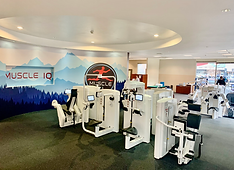Fax #: 801-377-3697





Journal of Muscle IQ
Journal of Muscle IQ - Volume 4
January of 2025
RESEARCH PAPER: How Pain Affects Muscle Performance - Conclusions from three research studies
Journal of Muscle IQ - Volume 4 - January of 2025
Author: Christopher P. Knudsen, DPT
Key words: Pain and Muscle Performance, Effects of Pain on Motor Control, Cortical Inhibition and Muscle Activation, Pain and Sensorimotor Integration.
ABSTRACT:
How Pain Affects Muscle Performance: Conclusions from three Scientific Studies
Pain, whether chronic or acute, significantly impacts how muscles perform by altering the brain's control over the muscles. Here’s an explanation of how pain affects muscle performance, based on the three studies, using clear language and examples.
1. Pain Inhibits Muscle Activation
- **Definition of Inhibition:** Reduced ability of the brain to send signals that activate muscles.
- **Study 1 Insights:** In chronic pain, like knee osteoarthritis (OA), certain brain circuits (intracortical inhibition) become more active. This is a protective mechanism to prevent overuse of painful muscles. However, this inhibition also reduces the muscle's strength and performance.
- **Example:** A person with chronic knee pain may have weaker quadriceps (thigh muscles), even if the muscle tissue itself is healthy. The brain reduces the activation of these muscles to avoid aggravating the pain.
2. Pain Alters Sensory-Motor Integration
- **Definition of Sensory-Motor Integration:** The process by which the brain combines sensory input (like touch or pain signals) with motor output (muscle activity).
- **Study 2 Insights:** Pain changes the way sensory signals from the body interact with motor areas in the brain. Normally, sensory input helps the brain adjust muscle activity. During pain, sensory input instead amplifies inhibitory circuits, reducing the muscles' ability to contract effectively.
- **Example:** If someone has wrist pain, the signals from the wrist's sensory nerves might suppress activation of the forearm muscles. This could make it harder to grip or lift objects.
3. Pain Causes Immediate and Prolonged Muscle Weakness
- **Definition of Corticomotor Output:** The brain's ability to send electrical signals from the motor cortex to muscles.
- **Study 3 Insights:** Acute pain, such as from a muscle injury or injection, causes a quick and significant drop in the brain's ability to activate muscles. This effect can last even after the pain subsides, with motor output and sensory processing suppressed for 25 minutes or more.
- **Example:** If someone sprains their ankle, they may struggle to activate their calf muscles fully, not just during the injury but also for a while afterward. This can delay recovery and lead to compensations in other muscles.
How Pain Affects Muscles Overall
1. Pain Reduces Muscle Strength:** Pain changes brain activity, reducing the signals sent to muscles, which weakens their ability to contract effectively.
- **Example:** Chronic knee pain weakens the quadriceps.
2. Pain Disrupts Coordination:** The brain struggles to balance sensory input and motor output, leading to less precise movements.
- **Example:** Wrist pain interferes with the grip.
3. Pain Prolongs Weakness:** Acute pain not only weakens muscles immediately but can also leave them underactive even after the pain goes away.
- **Example:** Ankle pain affects calf muscle strength long after the injury ends.
Key Takeaway for Muscle Performance
Pain creates a protective response in the brain that reduces muscle activation and alters coordination. While this helps prevent further injury, it also limits muscle performance, strength, and recovery. Effective pain management is crucial to restore normal muscle function.
Summary and Conclusions
These three studies explore the relationship between pain and its effects on motor cortex function, sensory-motor integration, and motor output. Below is a synthesis of their findings, explained in a way that highlights the underlying mechanisms.
### **Key Concepts and Conclusions**
#### **1. Chronic Pain and Motor Cortex Inhibition (Study 1)**
- **Key Findings:** Chronic pain from knee osteoarthritis (OA) alters cortical excitability markers, particularly intracortical inhibition (SICI and CSP). These markers are associated with adaptations to pain:
- Higher intracortical inhibition corresponds to better compensation and reduced subjective pain levels.
- ICF and MT appear to reflect more acute responses to pain, with higher values indicating better resilience to pain and anxiety.
- **Mechanism:** Chronic pain induces cortical reorganization, where inhibitory circuits in the motor cortex play a role in adaptation. This compensatory inhibition may serve to limit excessive motor responses or prioritize resources for managing pain.
#### **2. Sensory-Motor Integration and Facilitation (Study 2)**
- **Key Findings:** Short-latency afferent inhibition (SAI) interacts with excitatory motor circuits (SICF) in unexpected ways:
- SAI paradoxically enhances SICF, showing that sensory inputs modulate motor excitability.
- This effect occurs both at rest and during muscle contraction, indicating its relevance to functional motor control.
- **Mechanism:** Sensory inputs, through SAI, influence deeper motor circuits that project to the motor cortex. This interaction underscores the importance of sensorimotor integration in managing motor control during pain or other perturbations.
#### **3. Temporal Modulation of Sensory and Motor Processing During Acute Pain (Study 3)**
- **Key Findings:** Acute muscle pain suppresses both somatosensory processing (SEPs) and motor output (MEPs):
- This suppression occurs quickly after pain onset, persists even after pain resolution, and can last up to 25 minutes post-pain.
- The SEPs seem to influence motor pathways, suggesting a bidirectional relationship between sensory and motor processing.
- **Mechanism:** Pain-induced suppression may reflect a protective mechanism, where the nervous system prioritizes sensory signals over motor output, reducing the likelihood of further tissue damage.
---
### **Integrative Conclusions**
1. **Pain Alters Cortical Networks:**
- Pain, whether chronic or acute, changes cortical excitability by modifying inhibitory and excitatory circuits. These changes aim to protect the body, either by limiting unnecessary motor activity (acute pain) or adapting long-term motor control strategies (chronic pain).
2. **Sensory-Motor Feedback Loops are Key:**
- The interaction between sensory input and motor cortex output is central to pain adaptation. Pain shifts the balance between sensory processing and motor response, possibly to prioritize pain mitigation.
3. **Clinical Implications for Pain Management:**
- **Chronic Pain:** Interventions targeting intracortical inhibition (e.g., TMS, cognitive therapies) may help recalibrate maladaptive cortical changes.
- **Acute Pain:** Understanding the temporal suppression of motor and sensory processing can guide rehabilitation timing to optimize recovery after painful stimuli.
- **Sensorimotor Integration:** Therapies that enhance sensory-motor feedback (e.g., neuromodulation or functional movement exercises) could improve motor function in patients with pain.
Here are the Abstracts of the three scientific studies:
1. This study aims to investigate the associative and multivariate relationship between different sociodemographic and clinical variables with cortical excitability as indexed by transcranial magnetic stimulation (TMS) markers in subjects with chronic pain caused by knee osteoarthritis (OA). This was a cross-sectional study. Sociodemographic and clinical data were extracted from 107 knee OA subjects. To identify associated factors, we performed independent univariate and multivariate regression models per TMS markers: motor threshold (MT), motor evoked potential (MEP), short intracortical inhibition (SICI), intracortical facilitation (ICF), and cortical silent period (CSP). In our multivariate models, the two markers of intracortical inhibition, SICI and CSP, had a similar signature. SICI was associated with age (β: 0.01), WOMAC pain (β: 0.023), OA severity (as indexed by Kellgren–Lawrence Classification) (β: − 0.07), and anxiety (β: − 0.015). Similarly, CSP was associated with age (β: − 0.929), OA severity (β: 6.755), and cognition (as indexed by the Montreal Cognitive Assessment) (β: − 2.106). ICF and MT showed distinct signatures from SICI and CSP. ICF was associated with pain measured through the Visual Analogue Scale (β: − 0.094) and WOMAC (β: 0.062), and anxiety (β: − 0.039). Likewise, MT was associated with WOMAC (β: 1.029) and VAS (β: − 2.003) pain scales, anxiety (β: − 0.813), and age (β: − 0.306). These associations showed the fundamental role of intracortical inhibition as a marker of adaptation to chronic pain. Subjects with higher intracortical inhibition (likely subjects with more compensation) are younger, have greater cartilage degeneration (as seen by radiographic severity), and have less pain in WOMAC scale. While it does seem that ICF and MT may indicate a more acute marker of adaptation, such as that higher ICF and MT in the motor cortex is associated with lesser pain and anxiety.
2. In human, sensorimotor integration can be investigated by combining sensory input and transcranial magnetic stimulation (TMS). Short latency afferent inhibition (SAI) refers to motor cortical inhibition 20–25 ms after median nerve stimulation. We investigated the interaction between SAI and short-interval intracortical facilitation (SICF), an excitatory motor cortical circuit. Seven experiments were performed. Contrary to expectations, SICF was facilitated in the presence of SAI (SICFSAI). This effect is specific to SICF since there was no effect at SICF trough 1 when SICF was absent. Furthermore, the facilitatory SICFSAI interaction increased with stronger SICF or SAI. SAI and SICF correlated between individuals, and this relationship was maintained when SICF was delivered in the presence of SAI, suggesting an intrinsic relationship between SAI and SICF in sensorimotor integration. The interaction was present at rest and during muscle contraction, had a broad degree of somatotopic influence and was present in different interneuronal SICF circuits induced by posterior–anterior and anterior–posterior current directions. Our results are compatible with the finding that projections from sensory to motor cortex terminate in both superficial layers where late indirect (I-) waves are thought to originate, as well as deeper layers with more direct effect on pyramidal output. This interaction is likely to be relevant to sensorimotor integration and motor control.
3. Pain-related interactions between primary motor (M1) and primary sensory (S1) cortex are poorly understood. In particular, the time-course over which S1 processing and corticomotor output are altered in association with muscle pain is unclear. We aimed to examine the temporal profile of altered processing in S1 and altered corticomotor output with finer temporal resolution than has been used previously.
Methods
In 10 healthy individuals we recorded somatosensory evoked potentials (SEPs) and motor evoked potentials (MEPs) in separate sessions at multiple time-points before, during and immediately after pain induced by hypertonic saline infusion in a hand muscle, and at 15 and 25 minutes follow-up.
Results
Participants reported an average pain intensity that was less in the session where SEPs were recorded (SEPs: 4.0±1.6; MEPs: 4.9±2.3). In addition, the time taken for pain to return to zero once infusion of hypertonic saline ceased was less for participants in the SEP session (SEPs: 4.7±3.8 mins; MEPs 9.4±7.4 mins). Both SEPs and MEPs began to reduce almost immediately after pain reached 5/10 following hypertonic saline injection and were significantly reduced from baseline by the second (SEPs) and third (MEPs) recording blocks during pain. Both parameters remained suppressed immediately after pain had resolved and at 15 and 25 minutes after the resolution of pain.
Conclusions
These data suggest S1 processing and corticomotor output may be co-modulated in association with muscle pain. Interestingly, this is in contrast to previous observations. This discrepancy may best be explained by an effect of the SEP test stimulus on the corticomotor pathway. This novel finding is critical to consider in experimental design and may be potentially useful to consider as an intervention for the management of pain.
References
1. Increased motor cortex inhibition as a marker of compensation to chronic pain in knee osteoarthritis
https://www.nature.com/articles/s41598-021-03281-0
2.The influence of sensory afferent input on local motor cortical excitatory circuitry in humans
https://www.ncbi.nlm.nih.gov/pmc/articles/PMC4386965/
3. New Insight into the Time-Course of Motor and Sensory System Changes in Pain







